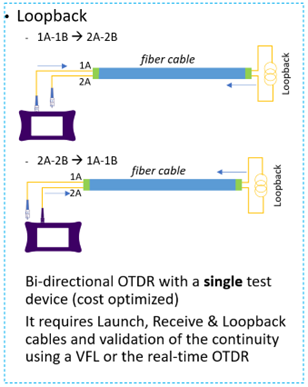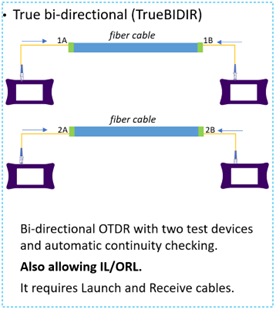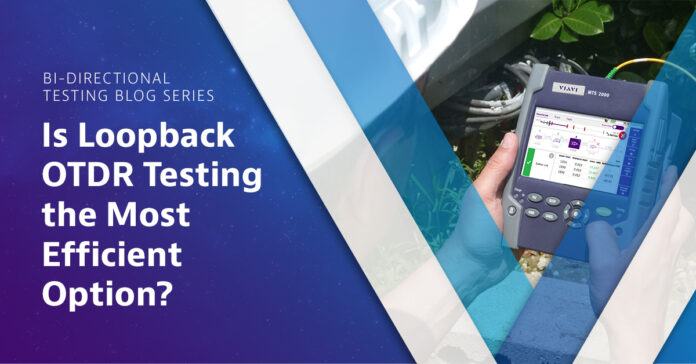First off, what is loopback OTDR testing?
The concept is simple: it involves using a single OTDR, which stays at one site, and testing two fibers at the same time by using a loopback fiber or loopback device at the other site.

And of course when it comes to OTDR testing you have the option of uni-directional (uni-dir) or bi-directional (bi-dir) certification, and in an earlier blog looks at the advantages of performing bi-dir test. Due to these advantages, the majority of fiber certification performed using a loopback OTDR method is bi-directional, so that’s the case we’ll consider here.
The test process is this: once the launch/receive and loopback fibers are inspected and connected, the fiber pair is tested in one direction (from 1A as shown above). The launch and receive fiber connections are then reversed and the fiber pair tested in the opposite direction (from 2A).
You have to make sure that your OTDR supports loopback testing. And by that I mean that its test applications or algorithms can automatically identify the loopback fiber and separate out the two fibers being tested. This will give you a set of results for each fiber in the pair; otherwise, there is a lot of post-processing work required with additional software to do that work. Fortunately, VIAVI OTDR do support loopback test so that’s all done on the instruments.
Human error is always a risk with loopback testing, and as most of the launch/receive cables and fibers being tested are all the same colour, it can be easy to make a mistake, A good tip is to use different colours for your launch/receive fibers so you don’t get muddled up and accidentally test the same direction twice, which would mean any bi-dir OTDR analysis would also be void.

So what are the advantages of loopback testing?
First, there is the test equipment saving, one instrument versus two … can’t argue with that one. Buying or renting one instrument is cheaper than two, or at least it may seem that way, particularly if you are talking about certifying a smaller number of fibers. (In future blogs we’ll look at the kind of time savings that can be achieved with a two-instrument approach.)
Next, testing two fibers at once cuts the number of tests you have to perform in half, so you appear to have an immediate 50% time saving. However, while it’s true that the number of tests is reduced, that’s just the testing time. There are still all of the other activities and steps which have to be performed (and those are very manual) so overall you never gain a full 50%.
So, what are the limitations?
You still need two technicians so you don’t save on labor, although the far-end tech is only performing end face inspection and moving a loopback fiber to the next fiber pair being tested.
Plus, as mentioned, the majority of loopback OTDR testing performed is for bi-dir certification, so you still have to perform two tests per fiber pair meaning there are still extra manual steps to disconnect/reconnect the OTDR test port and initiate the next acquisition. Then switch to the next fiber pair, confirm with the far-end tech (by phone or radio) that they are ready to go and again manually start a test. All of which creates pauses/delays between tests being initiated and wastes time. The start/stop nature creates an interrupted test flow and allows inefficiencies to creep in. This may not be much or critical when dealing with lower volumes of fiber, but it certainly adds up when you start to look at multi-fiber and high-fiber-count cables. We’ll look at this in more detail in a future blog in the series.
The use of receive fibers for bi-dir OTDR certification and what the industry standards have to say was also the topic of a previous blog.
Until recently, OTDR could help with part of the loopback test by automatically identifying the two fibers in the test result and separating them out into individual results files which could then be used for post-processing to perform the bi-dir analysis (loss averaging). VIAVI OTDR can now do the on-board bi-dir analysis too, we refer to it as TrueBIDIR.
Another limitation is the length of the link that can be tested. Two fibers means that the maximum link length you can test is halved, so loopback testing may not actually be an option if the total link length for two fibers (and launch/receive fibers) exceeds the maximum range of your OTDR.
Continuity testing also becomes a little more involved. You have to ensure the loopback device and receive fiber are connected correctly so you are testing the right pair of fibers. A visual fault locator (VFL) can be used for continuity test but they have a limited power output and therefore limited range (distance). Most techs opt for a real-time OTDR test to check for the presence of the loopback and receive fiber, but real-time OTDR results are always and only an OTDR trace (not a simple icon view). So you need a little more experience to read it and identify the loopback and receive fiber and then rely on the colour coding of launch/receive fibers to avoid connection errors.

However, the other option of using two instruments may initially cost more, but it has advantages:
- Enables testing of longer links
- Allows automatic continuity test
- Allows automation to be applied for optimization of test sequencing and results processing (provided you have a mechanism for exchanging data, in real-time, between near and far end units. Ideally this would be via the fiber under test, a VIAVI-patented capability, to make sure the testers are independent of internet access so you don’t have to rely on cloud applications to transfer data, especially when it comes to bi-directional OTDR analysis)
- Delivers better ROI over time (or over volume of fibers tested) and significantly better workflow when incorporated with a fully automated solution that includes an optical switch for batch testing and bi-directional OTDR results averaging/analysis (VIAVI’s FiberComplete PRO)
TestEquity are an approved UK partner for VIAVI
Is OTDR Testing Using a Loopback Method The Most Efficient Option for Fiber Certification?
Content Source: https://blog.viavisolutions.com/2023/02/27/otdr-testing-loopback/






